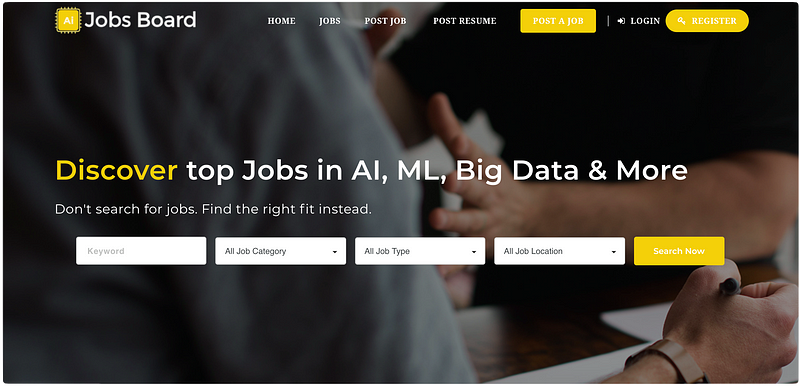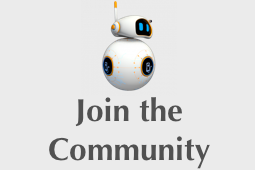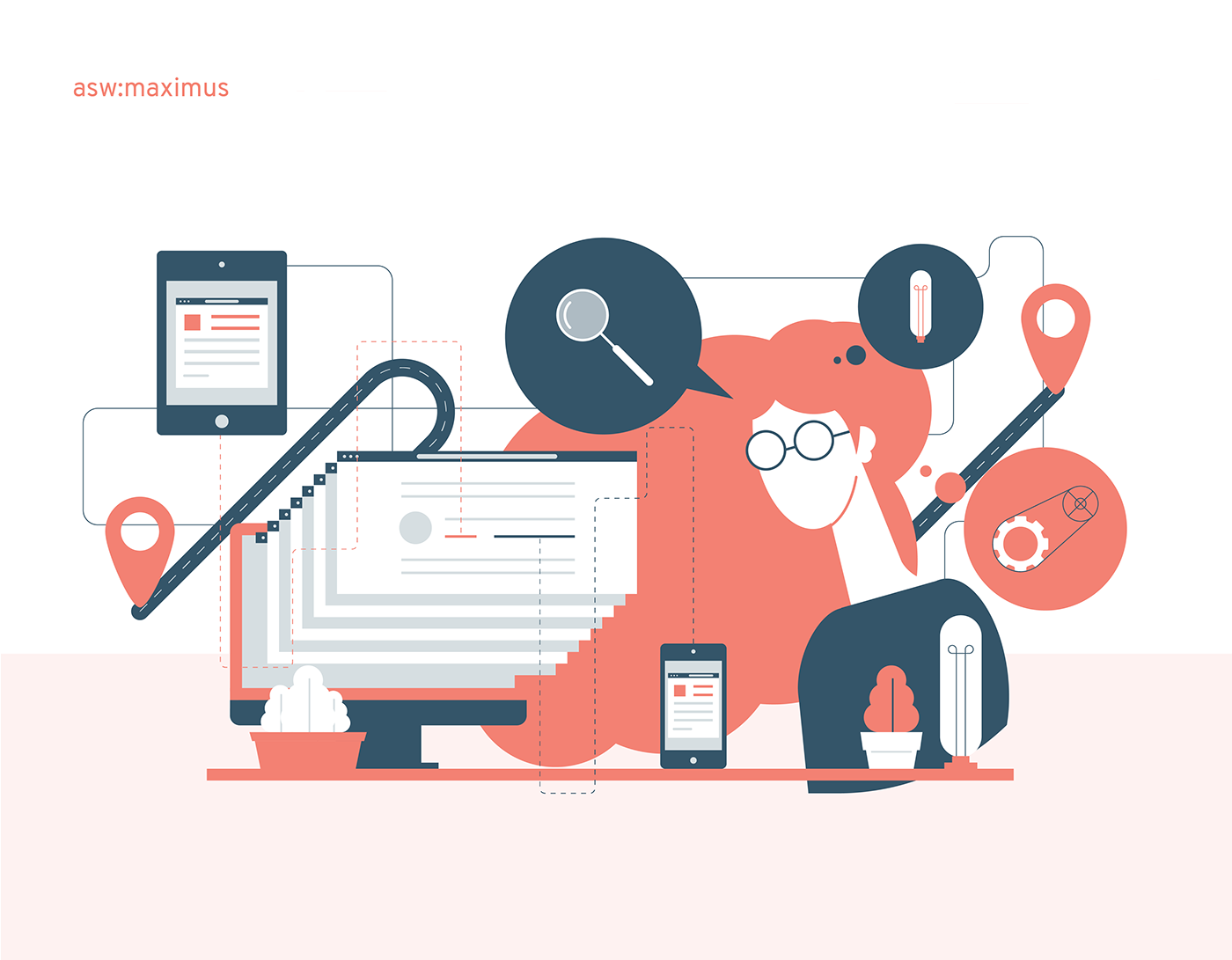
Society is changing at rates which can seem fantastical at times. Merely years ago we were blown away by the advancements in communication with cell phones, entertainment with the rise of streaming services, and the education with the rise of the internet giant.
A shifting from one big leap in The Industrial Age into the faster, cooler, sleeker Internet Age.
A time in which Sci-Fi is merely a calendar date away rather than an unforeseen fantasy.
A time in which the exponentially quick changing of technology is turning our eye to all the other problems that we have in the world, now that some of the heavy lifting is being outsourced to machines.
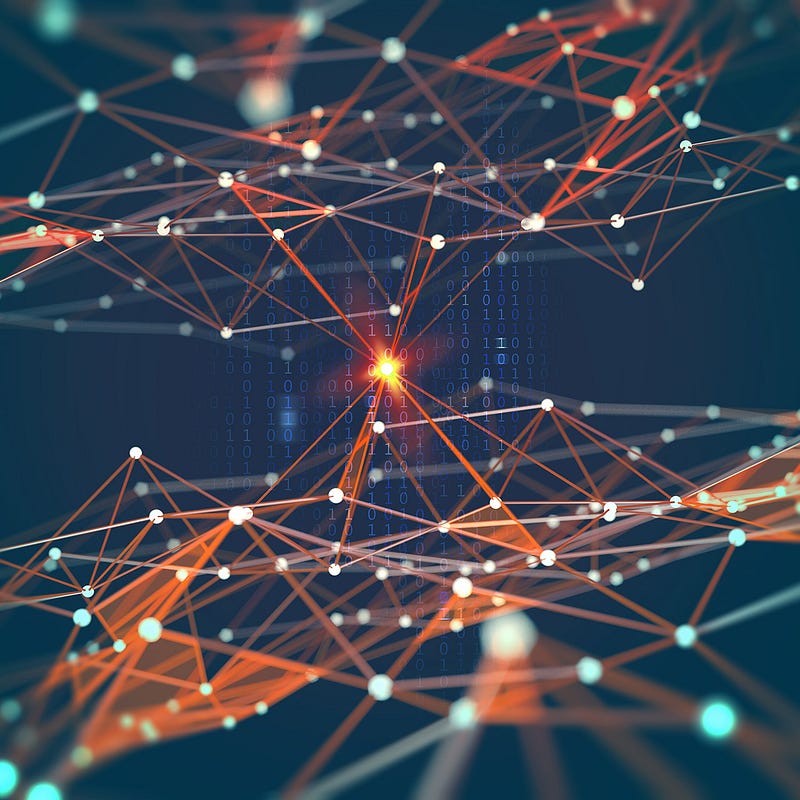
Yet, we do not want to put all the grunt weight of the world on the backs of the machines we have built, but instead, to create them in such a way as to be fellow protectors of our collective existence on our Planet Earth.
I like to think (and
the sooner the better!)
of a cybernetic meadow
where mammals and computers
live together in mutually
programming harmony
like pure water
touching clear sky….
~ from All Watched Over By Machines Of Loving Grace, Richard Brautigan
To begin moving towards making technology our partner in this endeavor, we must build them with the ability to adapt in similar ways to how we, as humans, do. By implementing what is now called Machine Learning, we are able to provide machines the ability to analyze, predict, and decide on levels previously only imaginable in reality, let alone our lifetime.
Machine Learning has been a hot topic in the fields of science and technology over the past few years, and is it really a wonder why? Day to day we use and are connected to several devices that we may not even realize use this technology. From evolving tech like our cars native GPS to Facebook Ads. Small to large scale, more and more devices that are used in everyday life utilize Machine Learning to some degree.
Big Data Jobs
And that begs the question: can this same technology be used on a large and more impactful scale than simply to make our daily lives more convenient in the present?
The most common definition held for what Machine Learning is changing and evolving as much as the technologies used, but overall, the consensus is that Machine Learning is “the process by which a computer is able to improve its own performance (as in analyzing image files) by continuously incorporating new data into an existing statistical model”(Merriam Webster). Simply stated, Machine Learning is giving machines the ability to perform actions without being explicitly instructed, i.e. learning.
We have embraced Machine Learning and Artificial Intelligence to the point where there seems to be 2 main fields of thought about the subject. It will either be the driving force that propels us into the future, or it will be the hammer that crushes us under our own humbrus. I hold the former.
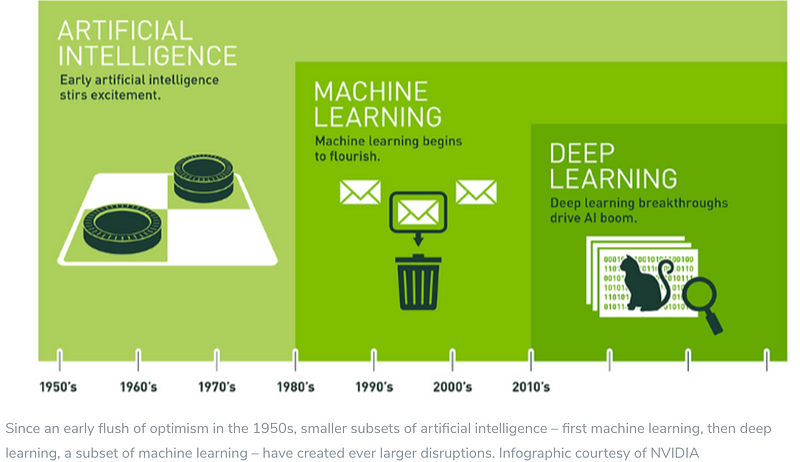
As with many developing (and developed) technology, there is a factor of fear and risk involved, but, as with every disaster and sci-fi/fantasy trope implores, we cannot use our powers for evil.
Therefore I want to briefly discuss some of the real world applications that we can use Machine Learning for right now that can help move us into the right direction of using power for the good of us all.
Our society is now a technologically driven one. Our advancements will continue to evolve, and just as with Time, if you do not move with it, then it will leave you behind. By using Machine Learning in Agriculture, Infrastructure, Healthcare, and Education, we can positively impact our Sociology.
Top 4 Most Popular Ai Articles:
3. Real vs Fake Tweet Detection using a BERT Transformer Model in few lines of code
Regardless of how many machines we implement into our lives, we still are human the the end of the day, and thus, we still require food. And with the life expectancy around the world increasing as we learn to take care of ourselves and each other, we require more food in order to sustain everyone.
Machines can help with that.
Right now there are researchers studying, by experiment, the use cases of Machine Learning in the field of food production.
In one particular study performed by Arti Singh, a “$499,845 grant from the U.S Department of Agriculture’s National Institute of Food and Agriculture to develop machine learning technology that could automate the ability of farmers to diagnose a range of major stresses in soybeans”, [2].
Following the research, and other study cases, it is found that there are several benefits to implementing such technologies, especially in the areas of Detection and Prevention, and Management.
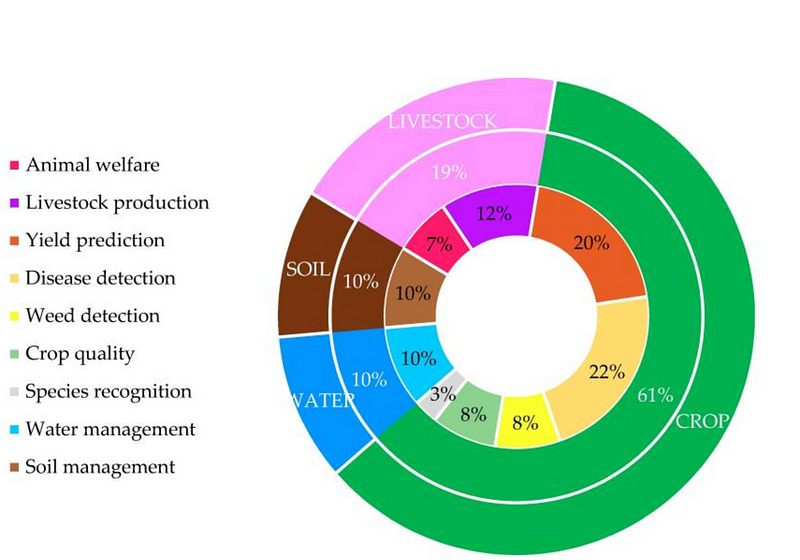
These machines can be used to automate the gathering of crops to reduce labor costs, detect and predict diseases, weeds, etc. to anticipate and plan for crop loss and adjust accordingly. This alone helps to increase crop quality and food production with less loss.
Managing animals, water, and soil would come as easily as sensors can be used to watch for sickness and degradation, signs of seasonal change, or identify patterns which can be used in implementing new processes.
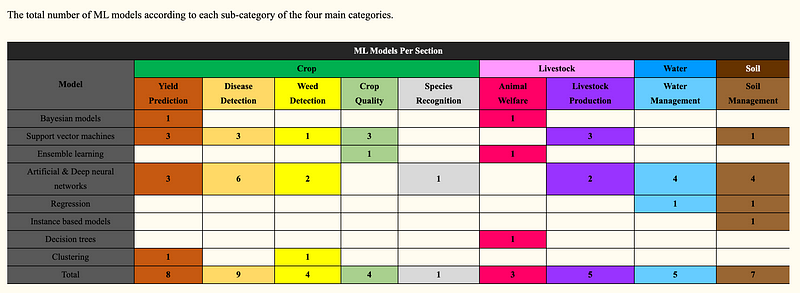
More info on different Machine Learning Techniques, visit https://machinelearningmastery.com/a-tour-of-machine-learning-algorithms/
Similarly to some of the benefits of using Machine Learning in agriculture, as it can be used to help sustain the health of humans through food, it can also be used to help maintain one’s health directly.
This however adds another layer of complexity as the data used in healthcare must be of a higher quality, reproducible, and credible, as it is much more integral in directly hindering or helping to save lives.
Across the board, ML is being used in the healthcare system already in such instances as Computer Vision for identifying patterns and possibly overlooked diseases, Natural Language Processing for Administrative tasks, and simply to accelerate the speed at which research and data can be identified and analyzed.
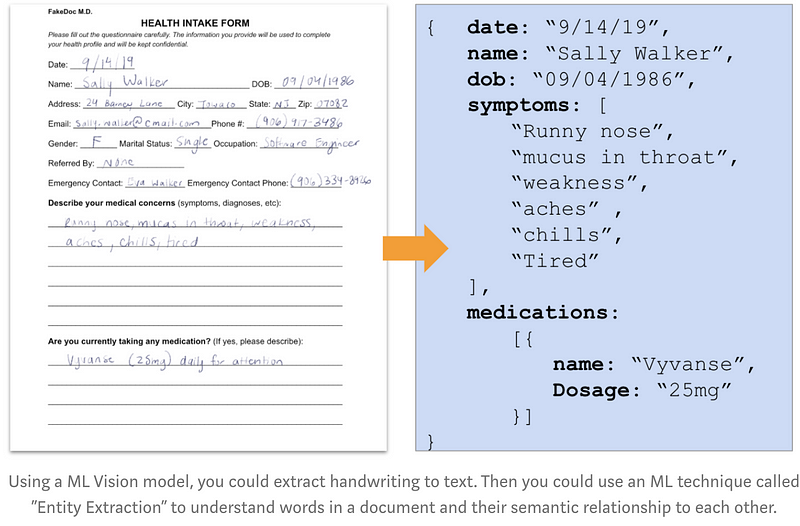
However, with so many factors taken into account in the field of medicine (the human body is a very complex biological machine in its own right), Machine Learning is used more as a system of support rather than a tool to stand alone. It then becomes a matter of impact in terms of how much better can ML perform in comparison to current tools.
“Measuring impact is likely the greatest challenge for machine learning algorithms, given that deploying an algorithm and showing its impact require additional resources.” [2]
If machines are to help humanity eat and stay healthy, then it would make sense then for humanity to grow and survive.
We would need space to hold all these humans, as technology is not built for the purpose of making people homeless. Ml can be used to help reimagine the design of buildings, predict room usage and occupancy, adjust design patterns accordingly to maximize space and usage.
“For now, architects are defining design goals and parameters, while artificial intelligence and machine-learning algorithms produce options for consideration.” [2].

As architectural designs become more based off of data heavy models, the potential use cases of machine learning continue to advance. Research coming from MIT predicts that, with the use of 3D printing and advances in fabrication, machine learning will become an integral part of the design and construction process. [3]
Just like any society in the past, in order for it to progress, the current state must be understood to a level to which it can be duplicated, but also the core concepts of how it functions must be passed down to generations upcoming.
This reason is why utilizing technology and machine learning in the education process is so important in the modern age. As these technologies are used in the daily world, it would be a wise move to begin integrating and explaining these technologies at a early stage, so as to provide more time to understand the concepts over the years.
Currently the education process relies heavily on inputting as much information as possible into a mind and testing knowledge based on the ability to recover that information as quickly and correctly as possible.
Does that not sound like the perfect use for a computer, whose main appeal is storing a lot of information, processing as fast and accurately as possible, and returning the output?
If properly utilized, this can take away the more tedious tasks of administrators and teachers and thus opening up that time for more personal interactions and educating. Tasks such as tracking student progress and administrative tasks (attendance, grading) can be automated.
When fully implemented, this can take pressure off unnecessary biases in the classroom while still providing a personalized teaching style to the student, both on and off campus.
“Machine learning promises to deliver custom in-class teaching by providing real-time feedback based on individual student behavior and other factors.” [4]
As an emerging technology, there are several tools on the market for testing and implementing Machine Learning. Of course it depends on the systems inputs, the desired end result, and the amount of resources (time, money, energy, processing power) that is able to go into the project.
A few more commonly used are:
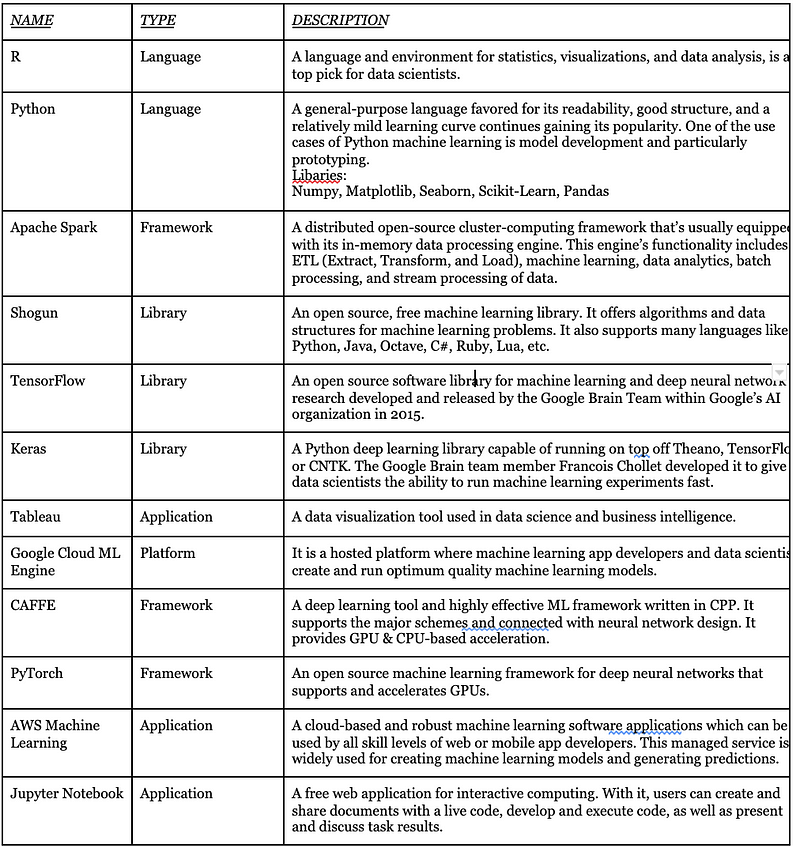
[1] [2] [3] [4]
Of course, with all the positives of what Machine Learning can be used for, there are bound to be some obstacles in the way (otherwise we would already have all of these technologies implemented).
As with any new technology, research, etc. there requires resources. For machine learning one of the big resources needed is processing power. It has been shown, similarly to Moore’s Law, which states that the number of transistors in a dense integrated circuit doubles about every two years, that the computational power needed each year doubles (exponential increase!).
Along that line of thought, data becomes a lot more crucial. The more of it, and the more accurate it is, the better for the model. It needs to be inclusive, unbiased, replicable, and of a good quality. Without the proper data to train a model on, then using that model again on a different dataset may not produce the desired results.
Of course, at the end of all the machine’s processes, there is a human to interpret and apply the results. This opens a completely different set of problems as it invites human error, misinterpretation, improper application, etc. Adding in the problem of the “Black Box” (not knowing how or why your model came up with a certain output), it becomes hard to diagnose an error in the results.
We could always remove the human interaction from the system, however that invites the question of ethics and the ‘darker side’ of Machine Learning.
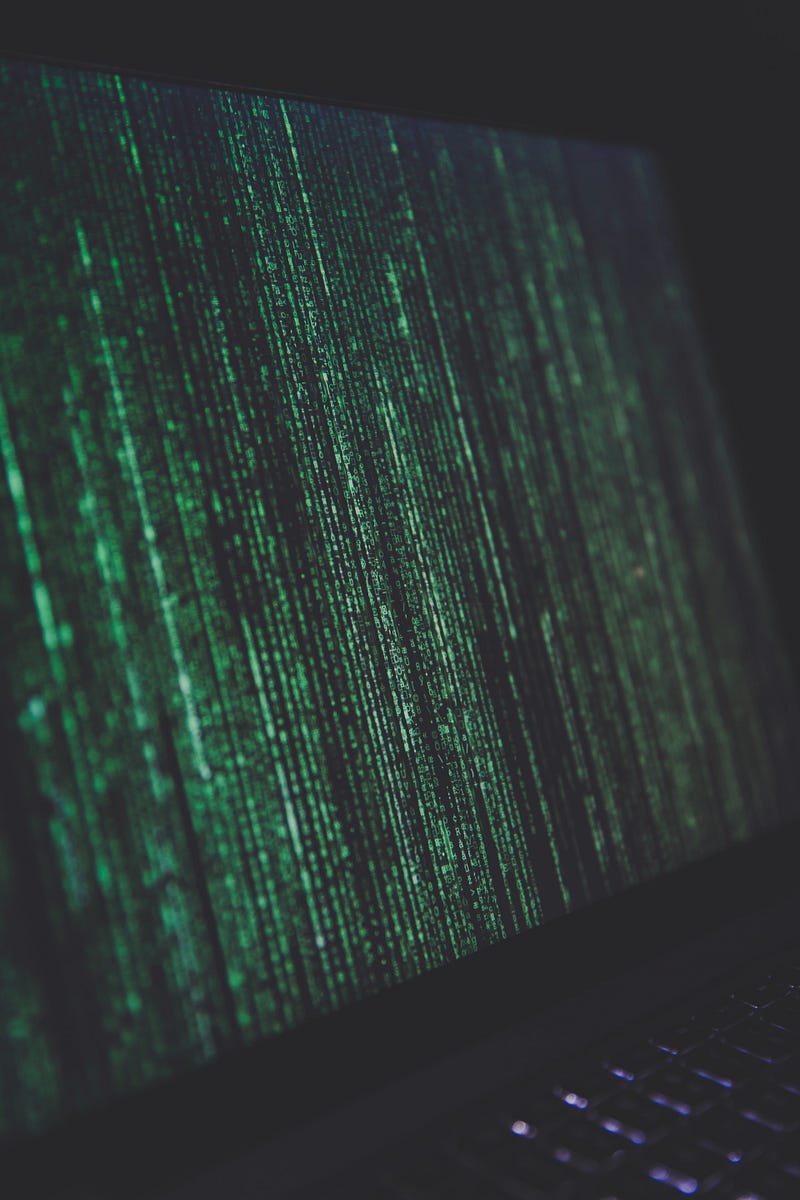
Popular Culture had indoctricnated into our minds the fears of Machine Learning and Artificial Intelligence potential for danger. From a Robotic takeover to an All-Seeing Big Brother Bot, we have transitioned into an age of datasim.
“Yuval Noah Harari famously coined the term ‘dataism’, which refers to a putative new stage of civilization we are entering in which we trust algorithms and data more than our own judgment and logic.”
Their machines are able to use this technology to harass people online, infer data that is not open to the public, emulate handwriting and voices, and even impersonate people as a whole.
Luka, a technology company, are able to use their algorithms to ‘reincarnate’ a dead person by using his text messages, social media conversations and other sources of information.
We have to start considering, and planning for, the implications of so deeply integrating this technology in our daily lives, in and outside the home.
“We must consider that while we cherish and harness the full power of machine learning … we also must speculate on and prepare ourselves for the broader implications.”
Technology is a marvel of the future. And we get to live in a time when we can both observe its evolution and participate in advancing it.
We are able to directly insert ourselves into the process of developing and using these technologies to progress our personal knowledge, the advancement of the technology in the Data Science field, and contribute to world wide problems by using Machine Learning to tackle some of these larger problems.
It is our responsibility, not only for our sake as people on this Earth, but as thinkers, inventors, and creators, to use the tools we have been given to take steps towards change.
… I like to think
(it has to be!)
of a cybernetic ecology
where we are free of our labors
and joined back to nature,
returned to our mammal
brothers and sisters,
and all watched over
by machines of loving grace.
~ from All Watched Over By Machines Of Loving Grace, Richard Brautigan
For time always moves forward, and if we don’t move with it, we all get left behind.
We are at a unique point in human history where the scope of our creative abilities are practically limitless and it is now a matter of acquiring the knowledge to be applied.
We are the only thing holding us back. Use the resources at your disposal to move yourself, and us all, into the future.
References
Quotes
Agriculture
- Liakos, K. G., Busato, P., Moshou, D., Pearson, S., & Bochtis, D. (2018, August 14). Machine Learning in Agriculture: A Review. Retrieved from https://www.ncbi.nlm.nih.gov/pmc/articles/PMC6111295/
- IowaStateUNews. (2019, September 12). Machine learning in agriculture: scientists are teaching computers to diagnose soybean stress. Retrieved from https://www.eurekalert.org/pub_releases/2019-09/isu-mli091219.php
- Rocha, J., & Rodrigues, L. H. A. (2013). Data Mining Techniques for Identification of Spectrally Homogeneous Areas Using NDVI Temporal Profiles of Soybean Crop. Retrieved from https://www.academia.edu/29940852/Data_Mining_Techniques_for_Identification_of_Spectrally_Homogeneous_Areas_Using_NDVI_Temporal_Profiles_of_Soybean_Crop
Healthcare
- https://www.anaconda.com/machine-learning-in-healthcare-5-use-cases/
- https://www.mckinsey.com/industries/pharmaceuticals-and-medical-products/our-insights/machine-learning-and-therapeutics-2-0-avoiding-hype-realizing-potential
- https://towardsdatascience.com/how-machine-learning-is-transforming-healthcare-at-google-and-beyond-d4f664b7e27c
Architecture
- https://www.researchgate.net/publication/325758928_Machine_learning_for_architectural_design_Practices_and_infrastructure
- https://www.archdaily.com/924704/buildtech-futures-artificial-intelligence-and-machine-learning
Education
- https://www.intechopen.com/books/machine-learning-advanced-techniques-and-emerging-applications/machine-learning-in-educational-technology
- https://aws.amazon.com/education/ml-in-education/
- https://edtechnology.co.uk/latest-news/insight-machine-learning/
- https://www.researchgate.net/publication/334546427_Applications_of_Machine_Learning_in_Improving_Learning_Environment
Tools
- https://www.altexsoft.com/blog/datascience/the-best-machine-learning-tools-experts-top-picks/
- https://www.softwaretestinghelp.com/machine-learning-tools/
- https://towardsdatascience.com/10-most-popular-machine-learning-software-tools-in-2019-678b80643ceb
- https://hackernoon.com/top-10-machine-learning-frameworks-for-2019-h6120305j
Rebuttal
- https://data-flair.training/blogs/advantages-and-disadvantages-of-machine-learning/
- https://techcrunch.com/2016/10/26/the-darker-side-of-machine-learning/
- https://towardsdatascience.com/the-limitations-of-machine-learning-a00e0c3040c6
- https://builtin.com/data-science/disadvantages-neural-networks
